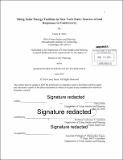| dc.contributor.advisor | Lawrence E. Susskind. | en_US |
| dc.contributor.author | Stein, Casey R | en_US |
| dc.contributor.other | Massachusetts Institute of Technology. Department of Urban Studies and Planning. | en_US |
| dc.coverage.spatial | n-us-ny | en_US |
| dc.date.accessioned | 2014-09-19T21:40:01Z | |
| dc.date.available | 2014-09-19T21:40:01Z | |
| dc.date.copyright | 2014 | en_US |
| dc.date.issued | 2014 | en_US |
| dc.identifier.uri | http://hdl.handle.net/1721.1/90105 | |
| dc.description | Thesis: M.C.P., Massachusetts Institute of Technology, Department of Urban Studies and Planning, 2014. | en_US |
| dc.description | Cataloged from PDF version of thesis. | en_US |
| dc.description | Includes bibliographical references (pages 120-130). | en_US |
| dc.description.abstract | Human reliance on fossil fuels has led to a wide range of adverse environmental and health effects. As our understanding of these impacts has grown, so has the search for other, more sustainable sources of energy. One such source is solar power, and the federal and state governments in the United States have created various policies and financial incentives to encourage adoption of solar energy technologies. While solar energy offers tremendous potential benefits, siting utility-scale ground-mounted photovoltaic arrays can give rise to strong public reaction. With this in mind, this thesis explores the controversy, or lack thereof, surrounding the siting of utility-scale solar energy facilities in New York by examining two case studies - the Skidmore College Denton Road solar array and the Cornell University Snyder Road solar array. While these two solar energy facilities share many commonalities, there is one key difference - the Skidmore College array created a much greater level of controversy than the Cornell University array. Analysis of this divergence indicates that choice of site is a crucial determinant of the extent of controversy. While local impacts are an important concern, this thesis demonstrates that the reasons for controversy go well beyond those impacts. Issues related to information, equity, and trust were other key sources of controversy. In addition to analyzing the sources of controversy, this thesis also offers some recommendations that may be helpful for entities involved in the development of solar power facilities. It is hoped that these recommendations will help to eliminate or mitigate future solar power siting controversies. | en_US |
| dc.description.statementofresponsibility | by Casey R. Stein. | en_US |
| dc.format.extent | 130 pages | en_US |
| dc.language.iso | eng | en_US |
| dc.publisher | Massachusetts Institute of Technology | en_US |
| dc.rights | M.I.T. theses are protected by copyright. They may be viewed from this source for any purpose, but reproduction or distribution in any format is prohibited without written permission. See provided URL for inquiries about permission. | en_US |
| dc.rights.uri | http://dspace.mit.edu/handle/1721.1/7582 | en_US |
| dc.subject | Urban Studies and Planning. | en_US |
| dc.title | Siting solar energy facilities in New York state : sources of and responses to controversy | en_US |
| dc.type | Thesis | en_US |
| dc.description.degree | M.C.P. | en_US |
| dc.contributor.department | Massachusetts Institute of Technology. Department of Urban Studies and Planning | |
| dc.identifier.oclc | 890144345 | en_US |

